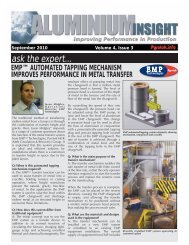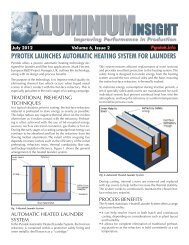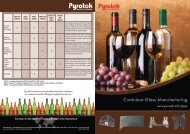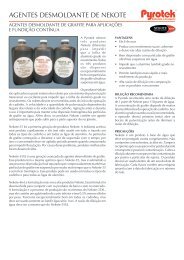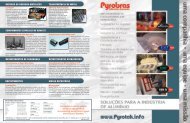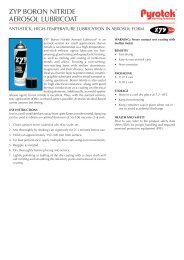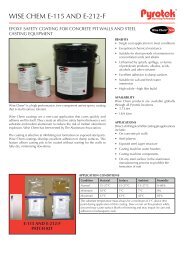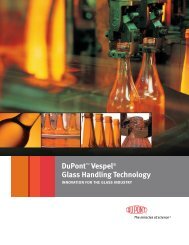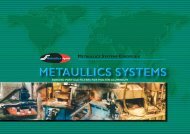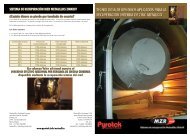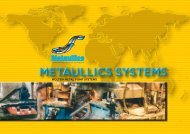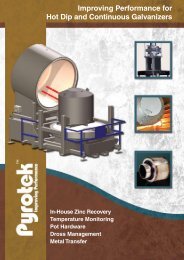GlassInsight_5-2013_.. - Pyrotek
GlassInsight_5-2013_.. - Pyrotek
GlassInsight_5-2013_.. - Pyrotek
Create successful ePaper yourself
Turn your PDF publications into a flip-book with our unique Google optimized e-Paper software.
4ask the expert...determining the best guidematerial in container productiongerresheimer group predictscontinued revenue growth in <strong>2013</strong>Gerresheimer AG, a Düsseldorf,Germany-based developer andmanuf-acturer of glass and plasticpackaging, projects its revenues willgrow 5–6 percent in <strong>2013</strong>. Its revenuesincreased 11.4 percent to EUR€1.2billion (USD$1.6 billion) in 2012.Larry Rizzuto,Glass Sales Engineer,<strong>Pyrotek</strong> Inc.In glass container manufacturing,bottle guides are an important componentwith various functions thatare used on individual section (IS)machines and the production line.If the forming process were an exactscience, there wouldn’t be any needfor bottle guides on the line’s deadplates, conveyor, ware-transfer unitor cross conveyor. Several factors thatinfluence ware handling, however,include container weight, variationsin air pressure, valve response time,timing parameters, machine cooling,deadplate cooling and man-coolingsystems.Many materials have been used overthe years as bottle guides, includingcovered wires, DuPont Kevlar ®tape, plastic tape, DuPont Teflon ®tubing, carbon, graphite and stainlesssteel. They are used for the sole purposeof guiding containers from thedeadplate to the machine conveyorto keep the containers from tippingover. Once on the conveyor, theyhave to be orientated in a straightline or a jam can occur.A container material’s resistance tohigh temperature and porosity determinewhich substance to use asbottle guides in any operation. If theguide material is damaged to a pointthat bare metal under the coating isexposed, a contact check can occuron the glass. If the material becomessaturated with oil, a contact checkmay also occur. Either of these conditionscan cause a container defectresulting in lost production or a customercomplaint.The following paragraphs detail thestep-by-step process of a container’strip from the IS machine to the annealinglehr.1. As a container leaves the deadplate,it can be directed by acurved guide, which is usuallymade of carbon or graphite. It maybe also assisted by air jets that turnon and off to hold the containerin the pusher pocket. Some operationshave used covered wiresor a coated tape to do the samething. The curved guide is the bestapproach because it will not dentthe container as a wire or tapemight do. The curved guide canbe made out of DuPont Vespel® SCP-5050 polyimide part or<strong>Pyrotek</strong>’s P-25W carbon / carbonmaterial.2. Once the container is moving onthe conveyor, an inside or outsideguide on the conveyor moves anymis-orientated containers back inline. The purpose of the guidesis to keep containers in a straightline through the narrow openingof the hot-end coating hood withoutjam-ming and to sequencethem into the ware-transfer unitwithout letting them fall over. <strong>Pyrotek</strong>has found that DuPont’sVespel ® SCP-5050 polyimidepart works best because it will resistoil, and won’t bend or easilybreak. Vespel ® components haveapproximately 50 to 100 timeslower heat transfer coefficientversus traditional carbon graphitecomponents, which can eliminatechecks and micro-cracks in theglass containers.3. Next, as a container contactstransfer fingers, the transfer unitwill turn the bottles 90 degreesto move them onto the cross conveyor.A guide under the transferkeeps the containers in a straightline as they enter the cross conveyor.Sometimes an upper guidemay also be used for added bottlestability. These materials are usuallymade out of graphite, carbon,polymer-matrix composite (PMC)or Vespel ® . The first three materialsmight break or wear out prematurely,causing downtime. Manyplants have been using Vespel ®components with good success.4. Once on the cross conveyor, thestacker will push the containersinto the annealing lehr. Temperaturesare very high in this area.Carbon material such as P-25Wis an excellent choice for stackerpocket inserts as temperatures aretoo high for Teflon ® , PMC and Vespel® materials. Graphite has alsohad its problems in this area as itwill cause contact checks on theside of the containers.To ensure glass container quality duringthe manufacturing process andavoid cost-inducing checks and defects,several ware-handling factorssuch as container weight or variationsin air pressure must be considered.<strong>Pyrotek</strong>’s global network of engineerscan work with a customer to determinewhich guides and materials willimprove production performance.www.pyrotek.info/glassDuPont, Kevlar ® , Teflon ® and Vespel ® areregistered trademarks or trademarks of E.I.du Pont de Nemours and Company or itsaffiliates. All rights reserved.The company saw strong growth inthe pharmaceutical segment, as wellas positive results in cosmetic glassand life science research.“We achieved all our targets in 2012.We recorded another year of stronggrowth in our business activities with Photo courtesy of Gerresheimer AG.the pharmaceutical sector, which onceagain proved to be relatively immuneto cyclical effects. We are investing heavily in expanding our production capacityfor medical devices such as prefilled glass syringes, insulin pens and inhalers.We are also focusing on the fast-growing emerging markets, especially in China,Brasil and India,” Uwe Röhrhoff, Gerresheimer’s CEO, said in a press release.The company is expanding its production capacity for medical products inGermany, the Czech Republic and elsewhere. Last year, Gerresheimer acquiredNeutral Glass, one of India’s leading manufacturers of pharmaceutical vials, andTriveni, an Indian plastic pharmaceutical packaging and closure manufacturer.The company is considering additional acquisitions, it says.Gerresheimer’s products include glass tubing, vials and syringes. Its RTF ® -brand ready-to-fill glass syringes can have multicolor printing, a laser-appliedidentity code and a tamper-evident closure system. They are also delivered tothe pharmaceutical industry sterile, pre-assembled and, if desired, with bakedonsiliconisation, the company says. Gerresheimer’s pre-fillable syringes can bemanufactured to a customer’s specifications and are technically compatible tostandards within the pharmaceutical industry.The company’s moulded glass packaging caters to the pharmaceutical, cosmeticsand specialty beverage industries. Its products include type I borosilicate glassand sodium-silicate glass of types II and III amber and flint glass, as well ascoloured and opal glass.Gerresheimer employs about 11,000 people at 47 locations in Europe, Northand South America and Asia.o-i, ecullet form joint ventureOwens-Illinois Inc. (O-I), of Perrysburg, Ohio, USA, and eCullet Inc., of PaloAlto, California, USA, have formed a joint venture called Glass to Glass LLC.The new company will invest in sophisticated glass sorting equipment that willmake more high-quality recycled glass available for use in O-I plants, Owens-Illinois says. Using recycled glass in the manufacturing process allows thecompany to reduce its use of virgin raw materials, lessening its environmentalimpact.“Much of the recycled glass collected in North America comes from singlestreamrecycling, which mixes paper, metal, plastic and glass,” Owens-Illinoissaid in a press release. “This collection process often results in glass that is toocontaminated to be successfully re-introduced into the manufacturing process.Improved sorting techniques will increase the amount of usable glass availableto O-I.”eCullet is a glass processing company that utilises proprietary technology toproduce high quality cullet (i.e. broken or refuse glass) that is colour sorted,contaminant free and furnace ready for the glass container manufacturingindustry.Separately, Glass International reports that O-I has completed a EUR€21 million(USD$27 million) investment at its Leerdam plant in the Netherlands to enhanceits capabilities. The investment included a furnace rebuild, machine upgradesand new equipment.“The investment at our Leerdam facility is part of O-I’s strategy to significantlystrengthen our competitiveness and capabilities in Europe. In <strong>2013</strong>, we will beinvesting EUR€140 million (USD$180 million) in our European operations,” O-IEurope President Erik Bouts told Glass International. “Over the next several years,we will accelerate our efforts to enhance O-I’s capabilities to better supportthe growing needs of our European customers for sustainable and healthy glasspackaging.”Owens-Illinois is the world’s largest glass container manufacturer with about22,500 employees at 79 plants worldwide. It had revenues of USD$7 billion in2012.



